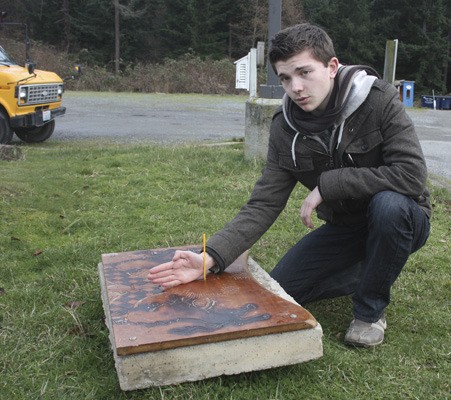Gregory Books wants teenagers to get excited about astronomical science. For one project his class dug debris out of their house gutters and using magnets determined that there were microscopic pieces of meteorites. He also had students brainstorm ways humans could live on Mars. Last fall he asked his class to build a sundial — not just a stick in the ground sundial, but one that would be adjustable for each season and daylight savings.
Two students, Christopher Babock and Matthew Bowen, created a sundial that impressed Books so much that he decided to install it on the lawn in front of the high school.
“It’s not just a great science project, but very artistic,” said Books. “They went above and beyond the call of duty.”
The sundial has a figure eight carving in its center called an analemma, which is the figure eight path that the sun makes in the sky. Bowen explains it like this: “imagine you had a camera pointed at the sky and at the same time and location you took a picture every day. All those images would create a figure eight pattern.”
Books added that the Earth does not orbit the sun in a circle, but in an ellipse, which creates the analemma.
In order to account for this pattern they made the rod, called a gnomon, in the center of the dial moveable by drilling holes along the center of the sundial. The holes are meant to represent each month, so that you can read the accurate time for each season.
The sundial is also built specifically for the island’s latitude, which is about 48 degrees north.
“The farther we are away from the equator the more oval the shape,” said Bowen.
The entire structure is moveable, so it can be placed in different directions to account for daylight savings .
This sundial was built with these particulars to make time accurate down to the minute, but what makes it unique is the artwork. Two beautiful carvings of lions decorated the surface. Bowen chose the animals because in some cultures they are a symbol of the sun.
“I’m pleased to have such a nice addition to our school,” said Books.




